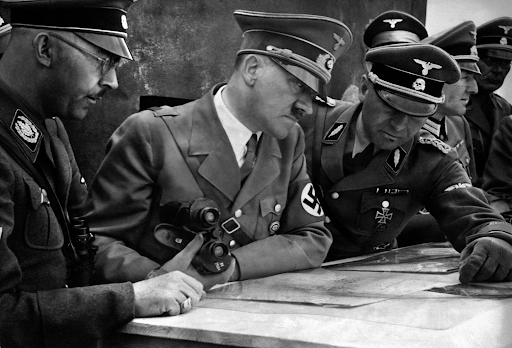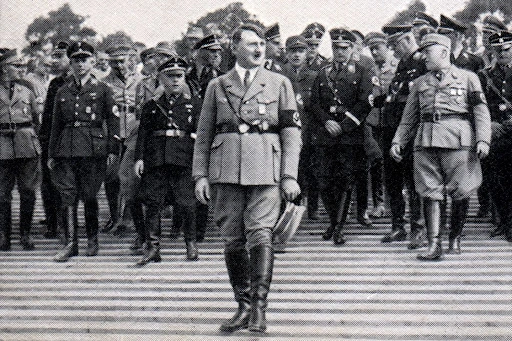
Adolf Hitler’s rise to power and the further actions of the Nazi Party remain a dark chapter in the history. Hitler rose to supremacy in Germany through a series of electoral victories that ended in his charge as Chancellor in 1933. He held on to power till his suicide in April 1945. Hitler consistently demolished Germany’s democratic institutions, transforming the nation into a militant state with the goal of beating Europe in the name of the so-called Aryan race. His attack on Poland on September 1, 1939, marked the beginning of the European phase of World War II. Throughout the war, Nazi forces committed evil acts, targeting 11 million individuals that were considered inferior or unwanted, including Jews, Slavs, homosexuals, and Jehovah’s Witnesses.
Hitler held the title of “führer” (leader or guide) and exerted supreme authority, but his rise and the cruelties committed during his rule were not solely his doing. He acquired active support from Germany’s powerful officer class and millions of ordinary citizens who sincerely embraced the National Socialist German Workers’ (Nazi) Party, celebrating him as a national savior in huge stadium meetups. The question that remains is how Hitler and the Nazis came to power in a country famous for its contributions to literature, art, architecture, and science, a nation that had a democratic government and a free press in the 1920s.
Hitler’s path to power started after he came back as a wounded veteran from the disastrous World War I. He, along with many patriotic Germans, was extremely furious and humiliated by the severe conditions imposed by the Treaty of Versailles. The Allies urged the German government, the Weimar Republic, to accept this treaty, which included exhausting war settling amounting to $33 billion. Germany also had to lose its overseas colonies and surrender valuable regions of its homeland to France and Poland. Similarly, Germany was severely limited in terms of its military capabilities. The load of these fixings led to economic instability and high rates of inflation, with 4 billion German marks equaling the value of one American dollar by September 1923. People had to use handcarts to carry enough paper money to buy basic needs like bread.

Hitler was famous for his incredible public speaking skills. He started communicating at political gatherings in Munich, supporting a new German order to replace what he observed as an unskilled and weak democratic regime. This expected New Order centered around an authoritarian political system, where supreme authority stemmed from a national leader. In this new Germany, all citizens would serve the state, democracy would be eliminated, and individual rights would be sacrificed in acceptance of the führer state. The Nazi Party’s supreme goal was to seize power through Germany’s parliamentary system, establish Hitler as a dictator, and create a community of culturally pure Germans devoted to their führer, who would lead them in a movement of racial purification and global supremacy.
Adolf Hitler’s beliefs and ideology were severely embedded in notions of racial dominance and an intense hatred for those he believed obnoxious. He stated, “Either victory of the Aryan or destruction of the Aryan and the victory of the Jew.” This viewpoint ascribed the weakness of the Weimar Republic to the effect of Germany’s Jewish and communist minorities, whom Hitler blamed for attempting to take control of the country. In Hitler’s world outlook, history was a persistent struggle among races, with the Aryan race being the strongest, intended to succeed through force. He claimed, “Mankind has grown great in endless war; it would decay in everlasting peace.” The Nazis hated Jews, associating them with elements they found obnoxious, including finance capitalism, international communism (notably due to Karl Marx’s Jewish background), and modernistic cultural movements like psychoanalysis and swing music.
The foreign policy of the Nazi Party was the goal of destroying Jews and other viewed “inferior” groups from Europe. Their goal was to expand Germany into a “Third Empire,” engaging pure-blooded Aryans and conducting persistent warfare against the Slavic populations of Russia, whom Hitler regarded as subhuman. Hitler was not only the chief organizer of the Nazi Party but also its abstract driving force. By 1921, the party had launched its own newspaper, an official flag, and a private army known as the Sturmabteilung (SA), primarily composed of unemployed and frustrated World War I veterans. By 1923, the SA had grown to 15,000 members and had access to hidden weapon stores.

In 1923, Hitler, along with World War I hero General Erich Ludendorff, tried to defeat the elected regional government of Bavaria in a coup known as the Beer Hall Putsch. However, the regular German army rapidly crushed the revolt. Hitler was later locked up for a year. By 1932, the Nazi Party had become the biggest political force in the Reichstag, Germany’s legislative body. In January of the following year, as no other leader could gather adequate support to lead, President Paul von Hindenburg selected Adolf Hitler as the Chancellor of Germany. After that, a fire incident happened at the Reichstag building in Berlin, and a young Dutch communist declared to start it. Instantly, Hitler started the dismounting of Germany’s democratic institutions while arresting his chief political rivals. When Hindenburg passed away, Hitler presumed the titles of Führer (leader), Chancellor, and Commander-in-Chief of the army.
Hitler’s significant military expenses and energetic public works initiatives, including the building of the German road highway system, seemed to bring economic prosperity to Germany. His rule also restrained the Communist Party and executed paramilitary stormtroopers, whose violent street protests had divided the German middle class. In 1938, Hitler began his long-expected growth of Germany’s borders to include ethnic German populations. He collaborated with Austrian Nazis to organize the Alliance, the takeover of Austria into Germany. In a fearless move, Hitler forced Czechoslovakia to surrender the Sudetenland, a gigantic region mainly inhabited by ethnic Germans.
Czechoslovakia sought support from Great Britain and France, but these nations, still healing from the destruction of World War I, opted to avoid war. At a meeting held in Munich in September 1938, British and French agents pushed Czech leaders to surrender the Sudetenland in exchange for Hitler’s promise not to pursue further landed gains. British Prime Minister Neville Chamberlain placed trust in Hitler’s words. Going back to Britain with the agreement in hand, Chamberlain magnificently declared that he had attained “peace with honor” and accepted it was “peace for our time.” However, a year later, German forces attacked Poland, triggering the outbreak of World War II. The Polish army fought bravely but could not resist when the Russian and Soviet armies attacked. By October 6, 1939 Germans had full control over Poland.

Germany’s invasion of Poland in 1939 became the cause of World War II. although it was not the only reason there are Various factors, including the rise of radical nationalism, U.S. isolationism, a failure to maintain a global balance of power, and the mislaid optimism that World War I had ended all wars, contributed to the global conflict. World War II was distinct from World War I in that civil victims greatly outnumbered military ones, mainly due to the rise of overhead combat and the bombing of cities. The Holocaust, a state-sponsored mass murder of six million Jews by the Nazis, was another terrifying aspect of the war, which also asserted the lives of millions of others.
Hitler’s army was fighting fiercely and was getting more power. But in the early days of 1945, Hitler seemed to fade away as Allied forces Great Britain, the United States, the soviet union, and France closed in against him. German army lost hope and was collapsing day by day. In this critical situation, Hitler decided to hide in his bunker in Berlin, where he directed the war strategists. The bunker, while resistant to bombings, couldn’t shield him from poor health and aging. As the Red Army entered in Berlin, Hitler rejected escape plans due to his fear of arrest. He commanded German troops to fight to the death but realized the hopelessness of the situation. Hitler totally lost hope. In this terrific situation, on the night of 29 April, he married Braun in a small ceremony.
Hitler’s Italian ally Benito Mussolini reported the horrifying situation of the war and informed him of the arrival of the Red Army. After analyzing all the circumstances he decided to take his own life. Eventually, on April 30, 1945, he and his wife Braun committed suicide in the Führerbunker. The death of Hitler signaled the end of Nazi Germany, closing in the Germans’ statement of unconditional surrender on May 8, 1945. So, after the death of Hitler, the World War II in Europe ended.





